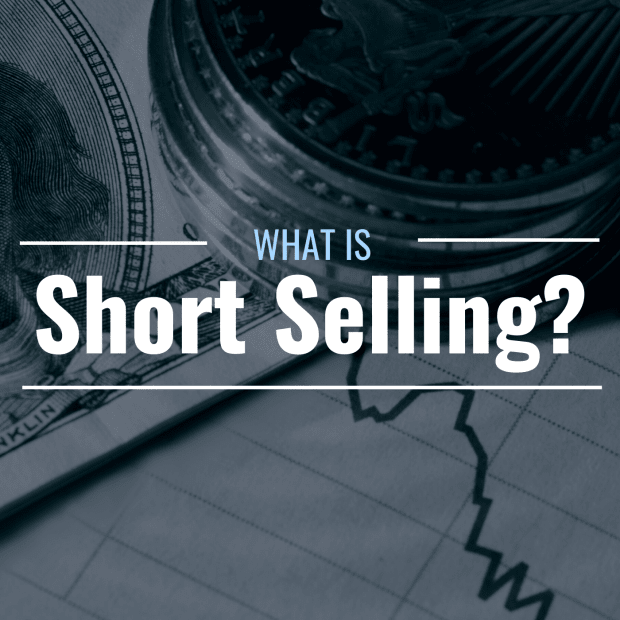
A_Carina from Getty Images Signature; Canva
What Is Short Selling?
Most investors understand the wealth-building concept of “buying low and selling high,” but the opposite is true when it comes to short selling. The goal of shorting, or short selling an asset, is to make a profit when its price falls.
Investors short a position by borrowing an asset, such as a share of a stock, a bond, or another security, from their broker, and sell these shares at market price. They then purchase the shares back at a lower price to return to their broker. The amount that the asset has declined in the meantime constitutes their profit.
Short selling can also transpire through options or derivatives trading. Here, an investor enters a short-selling trade by placing a sell-to-open order, and when they are ready to buy back the shares, they close the position through a buy-to-cover order. The upside of options shorting is that they have the option to sell the asset at a later date based on a fixed price in their contracts.
Why Do Investors Short?
There are several reasons for shorting an asset:
- It is a bearish strategy. Shorting is a way to capitalize on a likely decline in a stock, an industry, or even an entire market sector. Just as investors buy—or take a long position—in an undervalued company with the hopes its shares will rise, investors who short believe a company is overvalued and that its shares will soon decline.
- Short selling is a way to speculate. Since short trades are made using margin, the potential for profit is exponentially greater than simply investing with cash.
- Short selling is often used as a hedging technique. This means investors take a short position in an asset on which they have already gone long as a way to offset their risk.
How Does Short Selling Work?
There are three steps to executing a short sale:
- Set a stop order for protection in case the stock moves above this price level.
- Enter the short position.
- Close out the position, at or below the stop order.
Profitable Short Example
XYZ Corp. is trading at $50 a share. An investor borrows 100 shares and sells them for $5,000. XYZ Corp’s price suddenly declines to $25 a share, so they immediately purchase 100 shares to replace those borrowed. Their profit is $2,500.
Unprofitable Short Example
An investor enters a short position on XYZ Corp. by borrowing and selling 100 shares at $80, but instead of falling, it rises to $100. The short seller is required to return the shares. Then they buy 100 shares of XYZ Corp. at $100. They will have to spend $10,000 to pay back their borrowed shares, and this generates a loss of $2,000.
What Risks Are Involved With Short Selling?
When an investor buys a stock, their potential for loss is finite. For example, if they bought a stock at $10, and it went down to $0, they would suffer a complete loss of $10—but they would never lose more than that.
Margin buying, on the other hand, can have a much steeper downside than investing in cash, because one’s losses are compounded.
In this instance, if the investor in the example above shorts the same stock of XYZ Corp., but it actually goes up in value by $15, $20, or more their upside risk is infinite, meaning they could lose much more money than their original investment. This is why short selling is usually recommended only for advanced traders.
What Is a Short Squeeze?
If a stock’s price suddenly skyrockets, those investors who had shorted it quickly try to cover their positions by quickly buying shares. New investors notice the stock’s sharp rise and also build positions, prompting its price to rise higher still. This is known as a short squeeze, and it’s how short sellers can lose exponentially more than their initial investment. An example of this occurred with shares of Gamestop in 2021. Short sellers bet the stock would fall from its precipitous heights, but it didn’t—and analysts tally the shorting losses to be as high as $5 billion.
What Are the Regulation T Requirements for Short Selling?
The Federal Reserve Board has set requirements for short selling as a way to limit risk. These rules are known as Regulation T. In order to execute a short sale, an investor must have a margin account with their broker, which serves as collateral for the assets they are borrowing. Remember, when an investor buys on margin, they are borrowing funds they do not actually own. As with any loan, investors will have to pay interest on the assets they borrow. Regulation T also stipulates that investors cannot borrow more than 50% of the price of the shares on margin, as a way to limit the potential for losses.
Now let’s take another look at the example above and see what happens in the event the short sale becomes unprofitable.
What Is the Difference Between Selling and Short Selling?
In finance, a sell order refers to an investment that was purchased. After all, in order to sell an asset, a person must first own it.
The practice of short selling, on the other hand, refers to something that is borrowed using margin: It is not owned, and therefore there is a liability attached to it. In fact, the term “short” originated in the 1800s and meant something that was lacking, meaning the borrower had a deficit they needed to repay with their broker.
What Is Naked Short Selling?
Naked shorting is an illegal practice of selling shares that do not actually exist. This happens because when an investor enters a short position, which means they borrow shares of a stock, there is a 3-day window known as a settlement period during which their broker locates and delivers the shares to the investor. If these shares are not located, the position is considered to be naked. The practice of naked shorting can have grave effects on the stock market, artificially lowering stock prices as well as affecting liquidity.
Frequently Asked Questions (FAQ)
Below are answers to some of the most common questions investors have about short-selling that were not already covered in the sections above.
Can I Short Sell on Popular Trading Platforms like Robinhood, Ameritrade, Etc.?
At present, it is not possible to short-sell on Robinhood, although you can short-sell through other online platforms such as TD Ameritrade, Webull, and Charles Schwab.
Can I Short Sell with a Cash Account?
You cannot. Brokerages do not lend out stocks held in a cash account for short selling. Investors need to use a margin account set up by their broker to short stocks as well as follow regulations such as Regulation T, which limits the potential for losses, since short-selling comes with many risks.
Is Short Selling Bad or Good for the Market?
While the long-term trend for the market is up, short selling is a short-term trading technique that can generate profits, for instance, if a stock is overvalued relative to its fundamentals.
Should I Short in This Market?
We may be entrenched in a bear market, but TheStreet’s Brian O’Connell believes that stocks do not go down in the same manner they go up.







